Marraiges and Families: Intimacy, Diversity and Strenght Pdf Online
American sexual behavior is much different than it used to be. Today, most Americans think premarital sex is okay, and volition have three or more sexual partners before marrying. What, if annihilation, does premarital sex have to practice with marital stability?
This research brief shows that the relationship between divorce and the number of sexual partners women have prior to wedlock is circuitous. I explore this relationship using information from the three nigh recent waves of the National Survey of Family Growth (NSFG) collected in 2002, 2006-2010, and 2011-2013. For women marrying since the first of the new millennium:
- Women with 10 or more than partners werethe most likely to divorce, but this but became true in recent years;
- Women with 3-9 partners wereless likelyto divorce than women with 2 partners; and,
- Women with 0-i partners were theleast likely to divorce.
Earlier research establish that having multiple sexual practice partners prior to marriage could lead to less happy marriages, and often increased the odds of divorce. But sexual attitudes and behaviors continue to change in America, and some of the strongest predictors of divorce in years gone by no longer affair as much as they once did. In my 2005 bookUnderstanding the Divorce Bicycle, I showed that the transmission of divorce between generations became weaker as divorce grew more than common. Could the same thing have happened with sexual behavior? Somewhat surprisingly, the respond appears to exist no.
Even more noteworthy has been the decline in the proportion of women who go married having had only one sex partner (in most cases, their future husbands). Forty-three percent of women had simply i premarital sexual practice partner in the 1970s. Past the aughts, this was downward to 21 percent. Neither of these two trends changed much afterward the first decade of the 20-beginning century. Post-obit in the wake of the sexual revolution, the 1970s take been characterized as a decade of carnal exploration. Merely this doesn't seem to have been the instance for the vast majority of women who ultimately tied the knot in that decade: almost two-thirds of them had at most i sex partner prior to getting married. Fifty-fifty in the 1980s, slightly over half of women had a maximum of one sex partner before walking down the aisle. Things looked very different at the start of the new millennium.
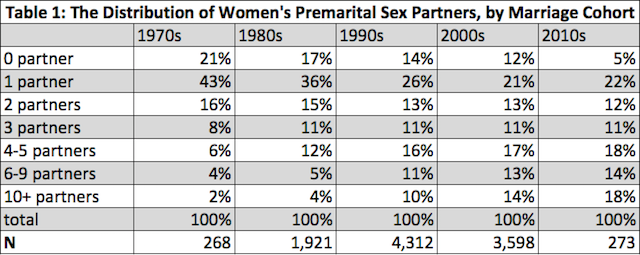
By the 2010s, merely 5 pct of new brides were virgins. At the other end of the distribution, the number of future wives who had ten or more sexual practice partners increased from 2 percentage in the 1970s to 14 per centum in the 2000s, and then to 18 per centum in the 2010s. Overall, American women are far more than likely to have had multiple premarital sex partners in contempo years (unfortunately, the NSFG doesn't take full data on men's premarital sexual behavior, and in any issue they recall their ain marital histories less reliably than do women).
Equally premarital sex became more than adequate, it'due south reasonable to anticipate that its negative effects on marital stability waned. In general, Americans became more accepting of nonmarital sexual practice. Certainly fewer men entered matrimony with the expectation of a virgin bride. All of the fanfare associated with hooking up is bear witness that some immature people accept become comfortable with the thought of sex exterior of serious relationships.
Be that equally it may, this prediction is only partially borne out by the data shown in Figure 1. The following chart depicts the percent of start marriages catastrophe in divorce within five years of wedlock according to the decade the wedding took place and how many sex partners a woman had prior to marriage.1 Consistent with prior research, those with fewer sex partners were less likely to divorce. However, at that place are considerable differences past union cohort. For all three cohorts, women who married as virgins had the everyman divorce rates past far. 11 percent of virgin marriages (on the part of the woman, at least) in the 1980s dissolved within five years. This number fell to 8 percent in the 1990s, then fell over again to half-dozen percent in the 2000s. For all three decades, the women with the 2nd lowest five-year divorce rates are those who had only ane partner prior to marriage. It's reasonable to assume that these partners reflected women's eventual husbands. Nevertheless, premarital sex with 1 partner substantially increases the odds of divorce.
In the 1980s and 1990s, the highest v-twelvemonth divorce rates were reserved for women who had 2 partners. The effect was specially stiff in the 1980s, when these women had divorce rates of 28 percent, substantially college than those of their peers who had x or more sexual practice partners prior to marriage (xviii percent). Fifty-fifty in the aughts, women who had two partners had, at xxx percent, the second highest divorce rates in the table.
The highest v-twelvemonth divorce rates of all are associated with marrying in the 2000s and having ten or more premarital sexual practice partners: 33 percent. Perchance it is not unexpected that having many partners increases the odds of divorce. The greater surprise is that this but holds truthful in recent years; previously, women with two partners prior to marriage had the highest divorce rates.
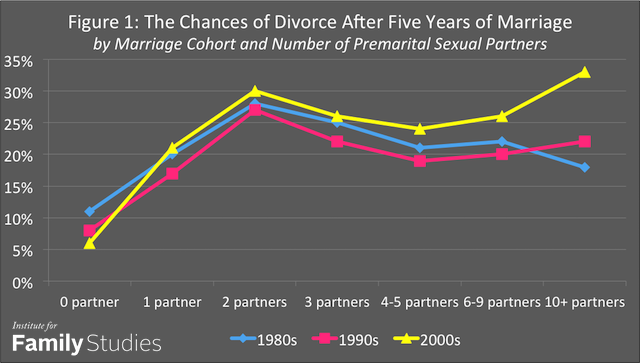
Source: NSFG, 2002-2013
How tin can these findings exist explained? It's easiest to make sense of the depression divorce rates of people with minimal sexual experience prior to marriage. Evidently, one of the virtually common reasons for premarital forbearance is faith, and NSFG data support such an estimation.2 Effigy 2 shows that women who ally as virgins are far more probable than other women to attend church at least in one case a week. Information technology'southward also noteworthy that virgin marriages increasingly became the domain of religious women between the 1980s and 2000s—and during the aforementioned years, the divorce rate for virgin brides connected to drib. These findings brand sense in light of the fact that people who attend church building frequently take lower divorce rates than exercise non-participants.
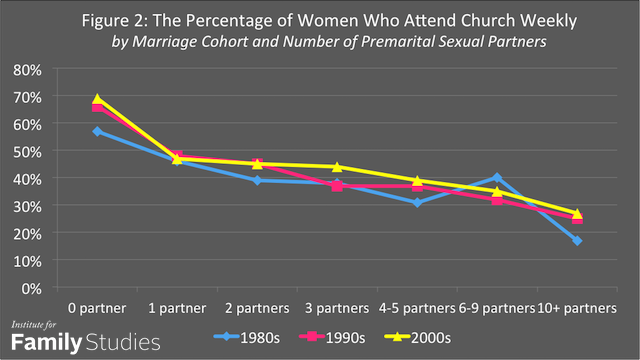
Source: NSFG, 2002-2013
Generally speaking, women who have multiple sex partners are less likely to be regular churchgoers. Since women with many partners don't consistently have high divorce rates, there is fiddling reason to suspect that religion is an of import caption for the relationship between sex partners and divorce outside of women who marry having had one or no partners.
Women who marry having had just one sex activity partner are unlikely to have had children with another man. Getting married with a child already in tow has a profound negative effect on marital happiness. And marriages preceded past nonmarital fertility have disproportionately high divorce rates. This is another reason why divorce rates are lower for women who marry having had only ane sex partner, or none at all. Ultimately we're left to speculate nigh why having exactly two partners produces some of the highest divorce rates.
My best guess rests on the notion ofover-emphasized comparisons. In most cases, a woman's 2 premarital sex partners include her future husband and one other man. That 2d sex partner is showtime-mitt proof of a sexual culling to 1'due south husband. These sexual experiences convince women that sex exterior of marriage is indeed a possibility. The man involved was likely to have become a partner in the course of a serious relationship—women inclined to claw up volition have had more than two premarital partners—thereby emphasizing the seriousness of the alternative. Of course, women learn near the viability of nonmarital sexual activity if they accept multiple premarital partners, but with multiple partners, each one represents a smaller part of a woman'due south sexual and romantic biography. Having two partners may lead to doubtfulness, simply having a few more apparently leads to greater clarity about the right man to marry. The odds of divorce are everyman with zippo or one premarital partners, only otherwise sowing one'southward oats seems uniform with having a lasting spousal relationship.
But non besides many oats, if one married later on the get-go of the new millennium. The highest divorce rates shown in Figure 1, 33 pct, belong to women who had 10 or more premarital sex partners. This is the upshot most readers of this brief probably expected: a lot of partners means a lot of luggage, which makes a stable wedlock less tenable. It'southward also entirely likely that the correlation is spurious, the production of certain personal characteristics. For example, people who suffered childhood sexual abuse are more likely to have all-encompassing sexual histories. Childhood abuse also increases the odds of a problematic marriage.
This is an farthermost instance. Nearly of the time, spuriousness probably has less measurable causes. Some people may just have a high level of sexual curiosity, an attribute that doesn't appear to bode well for a stable matrimony, at to the lowest degree since the starting time of the new millennium.
The odds of divorce are lowest with cipher or 1 premarital partners.
Two caveats are in order. Commencement, the 33 percent divorce figure for women with ten or partners who married in the 2000s is not statistically significantly higher than the xxx percent v-twelvemonth divorce rate for women who had two partners. Second, information technology is unknown equally to why having 10 or more partners has become more strongly linked to divorce only recently. This is a surprising development given the increasing frequency of having multiple partners, as well as people's greater overall acceptance of premarital sexuality. Perhaps this acceptance is more complex than has been best-selling. Having a handful of sex partners—anywhere between three and nine—may be perfectly acceptable, merely more than than that is problematic for marriage in a manner information technology didn't used to be. In whatever outcome, a total understanding is across the scope of this report.
Finally, I sought to explicate the relationship between premarital sexuality and marital stability via multivariate assay. More often than not speaking, major social and demographic differences betwixt survey respondents explain merely a modest portion of the relationship between numbers of sex partners and marital stability. At all-time, these differences account for about one quarter of the observed association betwixt sex partners and divorce. At worst, they brand essentially no difference. Due to the blueprint of the NSFG, a limited number of socio-demographic variables were acquiescent to analysis, including race, family structure of origin, urban vs. rural residence, age at marriage, and church attendance.
Aside from faith, race and family of origin accounted for the largest portion of the sexual partners/divorce relationship. Caucasian and African American women had similar premarital sexual behavior, but Latinas and members of the "Other" population group had notably fewer sex partners and lower divorce rates than either whites or blacks. Similarly, people who grew upward without both parents had more partners and divorced more. Detailed psychometric data would be necessary to further explain the relationship between numbers of sex activity partners and marital stability.
It won't be surprising to most readers that people with more premarital sex partners have higher divorce rates, broadly speaking. That said, this research cursory paints a adequately complicated motion-picture show of the association between sex activity and marital stability that ultimately raises more questions than it answers.
Nicholas H. Wolfinger is Professor of Family and Consumer Studies and Adjunct Professor of Sociology at the Academy of Utah. His most recent book is Soul Mates: Religion, Sex, Children, and Marriage among African Americans and Latinos, coauthored with West. Bradford Wilcox (Oxford University Press, 2016).
one. The figure depicts life table 5-year marriage failure rates. The sample sizes are too pocket-sized to wait at sex partners and divorce for marriages formed in the 1970s and the 2010s. Besides, the data don't permit the analysis of aforementioned-sex marriage.
2. Some caveats. Start, although church building attendance is a good measure of religious involvement, it doesn't fully capture religiosity. Second and more important is the fact that church attendance is measured at the time of the NSFG interview, so information technology might be a consequence also as a cause of marital behavior. Divorce affects religious participation: female NSFG respondents are almost 25 percent less likely to attend church oftentimes compared to married women. Accordingly, findings apropos faith should be viewed as suggestive rather than definitive.
Appendix:Cox Regression Estimates of the Effects of Premarital Sexual practice Partners and Other Factors on Women's Marital Stability in Starting time Marriages (Tables 1 - iv)
Notation: Results are hazard ratios indicating increased odds of divorce compared to reference category of 0 partners (total forbearance before marriage). For example, Tabular array i shows that women who married in the 1990s and had i premarital sex partner had 75% higher odds of divorce compared to women who married as virgins in the 1990s.
For all tables, Ns are:
1980s: 1,899
1990s: 4,292
2000s: 3,597
Ns are besides minor for analysis of divorce and sexual activity partners for people marrying in the 1970s and the 2010s.
* = not significant
** = p < .10
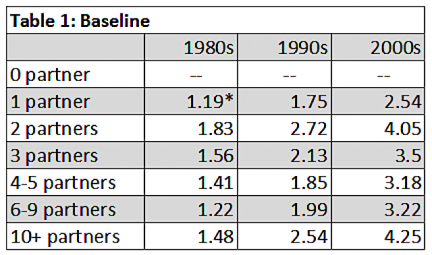
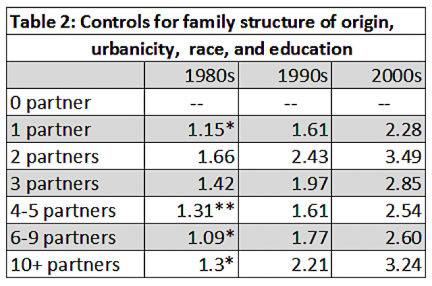
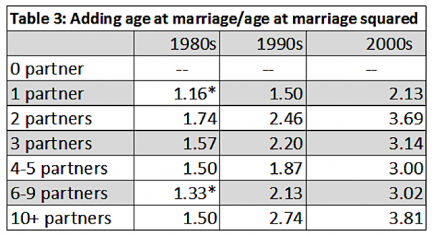
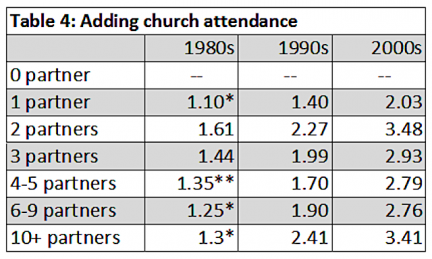
Source: https://ifstudies.org/blog/counterintuitive-trends-in-the-link-between-premarital-sex-and-marital-stability
0 Response to "Marraiges and Families: Intimacy, Diversity and Strenght Pdf Online"
Post a Comment